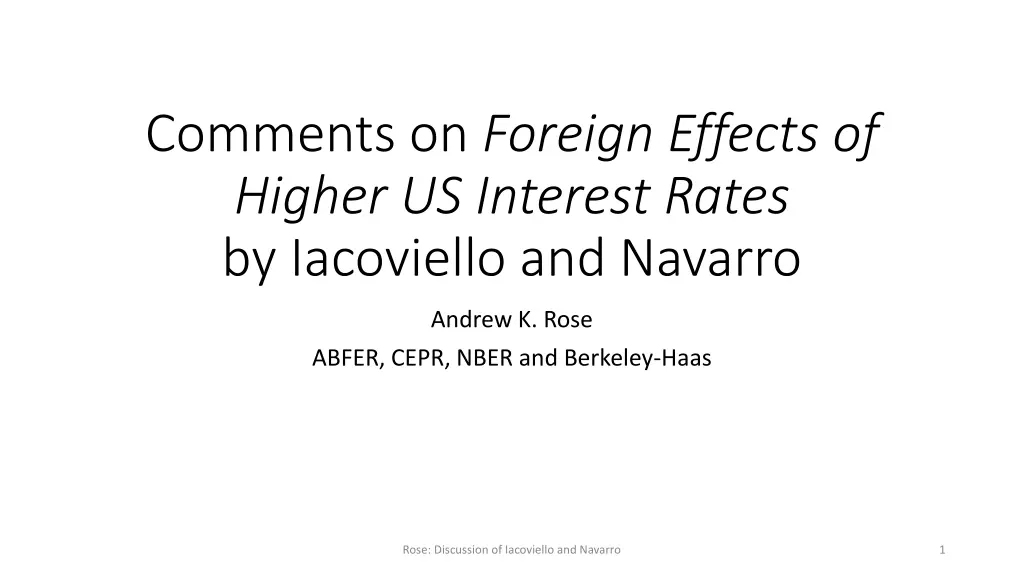
Understanding Foreign Effects of Higher US Interest Rates
Explore the discussion on the impact of higher US interest rates on foreign economies by Iacoviello, Navarro, and Rose. The empirical study delves into data issues, methodology challenges, and nationalistic considerations in a comprehensive analysis spanning multiple countries over several decades.
Uploaded on | 1 Views
Download Presentation

Please find below an Image/Link to download the presentation.
The content on the website is provided AS IS for your information and personal use only. It may not be sold, licensed, or shared on other websites without obtaining consent from the author. If you encounter any issues during the download, it is possible that the publisher has removed the file from their server.
You are allowed to download the files provided on this website for personal or commercial use, subject to the condition that they are used lawfully. All files are the property of their respective owners.
The content on the website is provided AS IS for your information and personal use only. It may not be sold, licensed, or shared on other websites without obtaining consent from the author.
E N D
Presentation Transcript
Comments on Foreign Effects of Higher US Interest Rates by Iacoviello and Navarro Andrew K. Rose ABFER, CEPR, NBER and Berkeley-Haas Rose: Discussion of Iacoviello and Navarro 1
An Important and Under-Studied Question So good motivation Rose: Discussion of Iacoviello and Navarro 2
Issues with Theory None; the paper is wholly empirical! So should judge paper by its two empirical parts Rose: Discussion of Iacoviello and Navarro 3
Issues with First Step (exogenous monetary policy shock) None Rose: Discussion of Iacoviello and Navarro 4
Only 2 Problems with Second Step (linking foreign output to monetary policy shock) 1. Data 2. Methodology Especially in Spillovers Choice of Mechanisms Methodology Rose: Discussion of Iacoviello and Navarro 5
Data Problems 50 Countries, 1965Q1-2014Q4 Hmm s Converting annual to quarterly data Extrapolating data backwards Footnote 10: To avoid dropping observations relative to our benchmark analysis, we fill in the missing observations using backward extrapolation. For instance, we assume that the current account position of a country in 1965-1969 is equal to its 1970 value Affects 26/50 countries! Most missing data is early in sample, during fixed exchange rate regime (selection bias?) Rose: Discussion of Iacoviello and Navarro 6
Some Nationalistic Bitching P13: Canada, for instance, was closely pegged to the dollar until 2002, kept a managed floating regime between 2002 and 2010 Rose: Discussion of Iacoviello and Navarro 7
Footnote 1. The last time the Bank intervened in foreign exchange markets to affect movements in the Canadian dollar was in September 1998. Written in March 2011! Rose: Discussion of Iacoviello and Navarro 10
Europe: Problematic for $-Bilateral Approach 50 Countries Some countries moved from 2nd world to 3rd world to 1st world China, Czech Republic, Hungary, Poland (China has made first step) Seems odd to estimate time-invariant functions for these More Serious: Europe per se 12 countries in EMU a large open economy, mostly unaffected by America after 1971 (compared with Germany) 8 are affected by EMU/Germany more than America Czech Rep, Denmark, Iceland, Norway, Poland, Sweden, Switzerland, UK These 19 should be re-centered on Germany (and Germany dropped) Reason for excessively large number of rich floating exchange rate observations (80%) Rose: Discussion of Iacoviello and Navarro 11
Mechanisms Here: 1. Exchange Rate Regime against US$ 2. Trade Openness vis- -vis US 3. Index of Financial Conditions Vulnerability Index Itself a principal component of inflation, output gap, current account deficit Don t seem mostly financial Why this list? Rose: Discussion of Iacoviello and Navarro 12
What About? 1. International Reserves (East Asians, Frankel) 2. External Debt (especially if denominated in FX, Calvo) 3. Capital Controls (most academics) 4. Credit Growth (Borio) 5. Government Debt (Germans) 6. Asset Price Bubbles (MacroPru types) Rose: Discussion of Iacoviello and Navarro 13
Methodology Why use a PC of 3 variables (inflation ) rather than 9 separately? Foreign GDP is a cause of US monetary shocks (eqn 1) Legal? Note: also caused by US monetary shock Note: also part of transmission mechanism (in index of financial conditions) May be hard to disentangle roles Rose: Discussion of Iacoviello and Navarro 14
Methodology: somewhat contrived Ex 1: Interactions of section 5.1 consists of 5 (!) steps: 1. Standardization 2. Logistic transformation 3. Re-centering 4. Interacting 5. Recursively orthogonalizing Ex 2: Index of financial conditions is principal component of 3-year moving averages of 3 fundamentals (inflation, ) truncated at 5% Is this complexity really necessary? Simpler is more plausible, perhaps less sensitive Why not just add interactions directly or split sample? Rose: Discussion of Iacoviello and Navarro 15
Bottom Line Their conclusions: Using a panel (with cross-section AND time-series variation) is best Large response of foreign output ( US) to tighter American monetary policy Lots of Heterogeneity in foreign responses Advanced: Tighter trade and FX links (fixing) make for bigger response (classic SOE) Emerging: Financial vulnerability makes for bigger response All completely sensible, well-aligned with my priors Large Number of Issues with Empirics So I believe their conclusions Don t believe their evidence No Bayesian updating Rose: Discussion of Iacoviello and Navarro 16
Minor Tabulate results of estimation of (1) Why 68% confidence intervals? Dynamic responses of Figure 4 seem way too slow compared to conventional wisdom of Debt and Tequila crises Foreign effects look permanent are they? 5.1 and 6.1 are hard to follow Make figures readable in B&W Rose: Discussion of Iacoviello and Navarro 17
